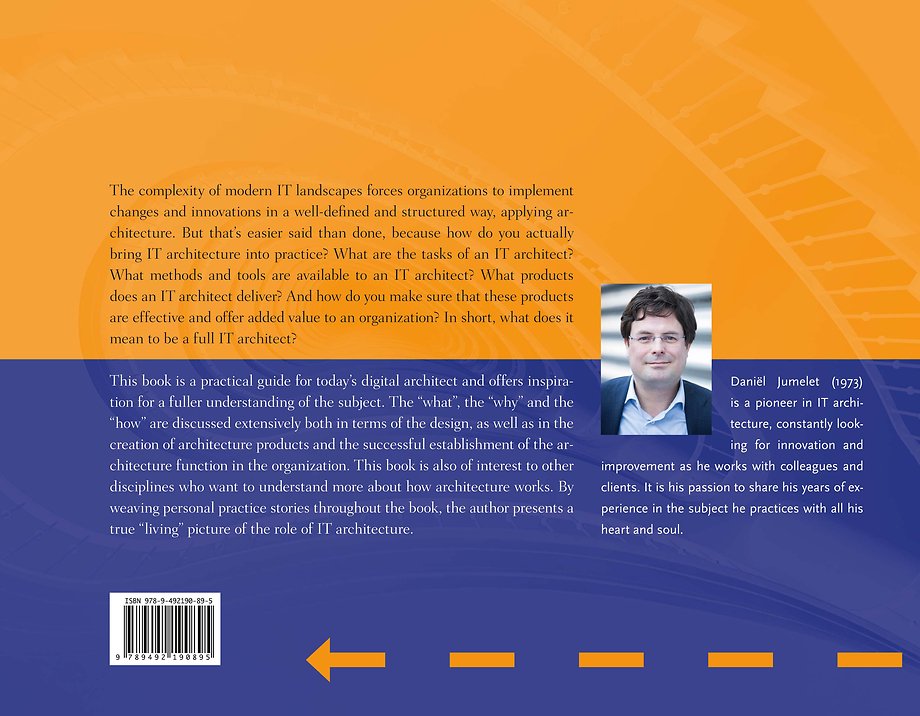



Daniël Jumelet (1973) is sinds 1994 werkzaam in de IT. Sinds 2005 doet hij onderzoek in de praktijk naar de toepassing van architectuur op infrastructuur.
Meer over Daniël JumeletLevende IT-architectuur
Praktische toepassing van een functiegerichte aanpak
Samenvatting
De complexiteit van moderne IT-landschappen dwingt organisaties om veranderingen en vernieuwingen onder architectuur door te voeren. Maar dat is eenvoudiger gezegd dan gedaan. Want hoe beoefen je IT-architectuur in de praktijk? Wat zijn de taken van een IT-architect? Welke werkwijzen en hulpmiddelen staan een IT-architect ter beschikking? Welke producten maakt een IT-architect? En hoe zorg je ervoor dat die producten effectief zijn en toegevoegde waarde bieden aan een organisatie? Kortom, wat betekent het om een volwaardig IT-architect te zijn?
Dit boek is een praktische gids voor de hedendaagse digitale architect. Het biedt inspiratie voor de verdieping van het vak. Het 'wat', het 'waarom' en het 'hoe' komen uitgebreid aan bod, zowel ten aanzien van het ontwerpen zelf alsook het vervaardigen van architectuurproducten en het succesvol maken van de architectuurfunctie in de organisatie. Ook voor andere doelgroepen is het boek interessant, omdat het een mooi kijkje geeft in de keuken van de IT-architect. Door in ruime mate persoonlijke praktijkverhalen door het boek heen te weven heeft de auteur ervoor gezorgd dat met recht gesproken kan worden van 'leve(n)de IT-architectuur'.
Trefwoorden
Specificaties
Inhoudsopgave
Preface
Chapter 1 Introduction
1.1 Major tasks of an IT architect
1.2 The insights and skills of the IT architect: how to read this book
1.3 The main messages of this book
Personal practical stories
A few asides
Chapter 2 The role of architecture in the development process
2.1 Phases of the design: the development sequences
2.2 In detail: steps in the architecture continuum
2.3 Involvement of stakeholders
The role of the community
Chapter 3 The making of function models: the heart of architecture
3.1 Patterns
3.2 A lexicon for infrastructure functions
3.3 ArchiMate: a semantic for the modeler
3.4 Application of the OIAm model approach outside of the infrastructure domain
Handling data center transitions
Chapter 4 Working with models: examples
4.1 Example 1: The Exchange migration
4.2 Example 2: Identity Management for cloud solutions
Design of workplace services
Chapter 5 Ingredients of architecture products
5.1 User stories
5.2 Service descriptions
5.3 Quality aspects
5.4 Environments
5.5 User categories5.6 Principles5.7 Architecture Building Blocks
5.10 Threat analyses
Working on Architecture repositories
Chapter 6 Architectural products
6.1 Organization Context Analysis (OCA)
6.2 Business-IT plan, roadmap and project calendar
6.3 Architecture repository
6.4 Business case / impact analysis / feasibility study
6.5 Project Start Architecture (PSA), Sourcing Start Architecture (SSA) and Solution Foundation
6.6 Root cause analysis
Functional tenders
Chapter 7 Embedding architecture
7.1 Goals
7.2 Processes
7.3 Roles
7.4 Architecture products
7.5 Strategic partners
7.6 Governance
7.7 Making architecture visible
Office politics: decision support
Chapter 8 Infrastructure architecture and IT security
8.1 Strategy determination
8.2 Threats and risk analysis
8.3 Mitigation8.4 Example of a threat analysis
8.5 Security Management
8.6 Privacy protection
Coping with trends
Appendix A Introduction to OIAm
A.1 What is OIAm?
A.2 The focus of OIAm
A.3 What does OIAm offer?
A.4 History of OIAm
A.5 What remains outside the scope for OIAm?
Appendix B Modeling protocols for the application of ArchiMate
B.1 The use of ArchiMate
B.2 Preferred concepts in infrastructure
B.3 Relationship conventions
B.4 Relationships between views and layers
Appendix C Cloud Service Packages
C.1 Application Hosting
C.2 Web Hosting
C.3 Calculation
C.4 Data Management
Glossary
References
Vergelijkbare boeken
Anderen die dit boek kochten, kochten ook
Rubrieken
- cadeauboeken
- computer en informatica
- economie
- filosofie
- flora en fauna
- geneeskunde
- geschiedenis
- gezondheid
- jeugd
- juridisch
- koken en eten
- kunst en cultuur
- literatuur en romans
- mens en maatschappij
- naslagwerken
- non-fictie informatief/professioneel
- paramedisch
- psychologie
- reizen
- religie
- schoolboeken
- spiritualiteit
- sport, hobby, lifestyle
- thrillers en spanning
- wetenschap en techniek
- woordenboeken en taal









